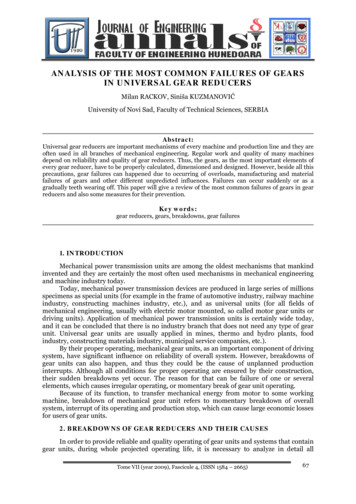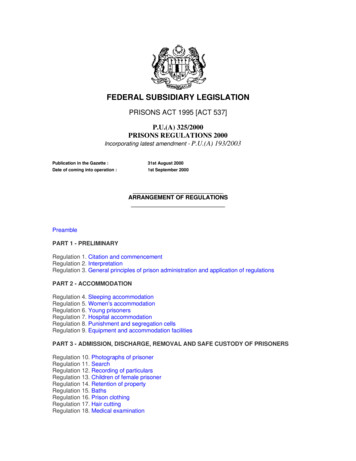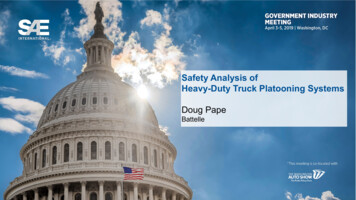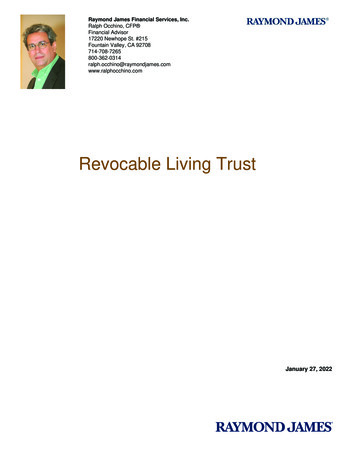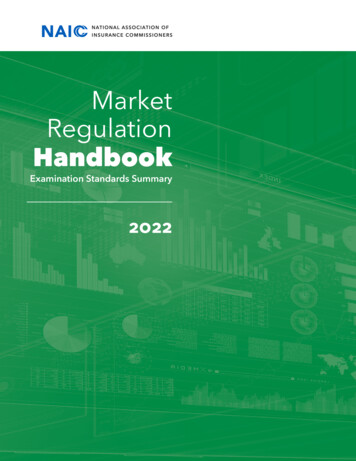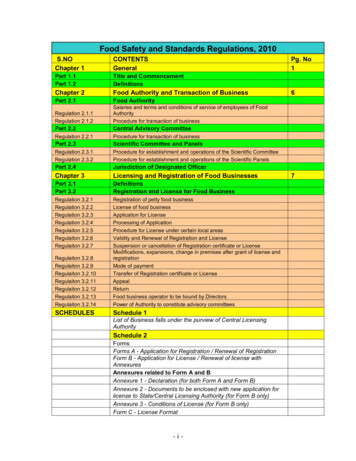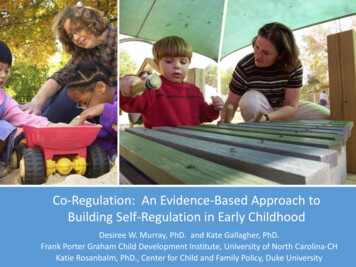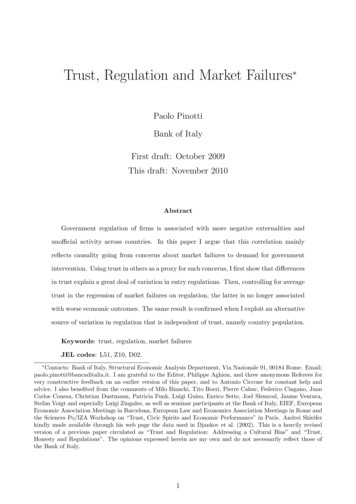
Transcription
Trust, Regulation and Market Failures Paolo PinottiBank of ItalyFirst draft: October 2009This draft: November 2010AbstractGovernment regulation of firms is associated with more negative externalities andunofficial activity across countries. In this paper I argue that this correlation mainlyreflects causality going from concerns about market failures to demand for governmentintervention. Using trust in others as a proxy for such concerns, I first show that differencesin trust explain a great deal of variation in entry regulations. Then, controlling for averagetrust in the regression of market failures on regulation, the latter is no longer associatedwith worse economic outcomes. The same result is confirmed when I exploit an alternativesource of variation in regulation that is independent of trust, namely country population.Keywords: trust, regulation, market failuresJEL codes: L51, Z10, D02. Contacts: Bank of Italy, Structural Economic Analysis Department, Via Nazionale 91, 00184 Rome. Email:paolo.pinotti@bancaditalia.it. I am grateful to the Editor, Philippe Aghion, and three anonymous Referees forvery constructive feedback on an earlier version of this paper, and to Antonio Ciccone for constant help andadvice. I also benefited from the comments of Milo Bianchi, Tito Boeri, Pierre Cahuc, Federico Cingano, JuanCarlos Conesa, Christian Dustmann, Patricia Funk, Luigi Guiso, Enrico Sette, Joel Slemrod, Jaume Ventura,Stefan Voigt and especially Luigi Zingales, as well as seminar participants at the Bank of Italy, EIEF, EuropeanEconomic Association Meetings in Barcelona, European Law and Economics Association Meetings in Rome andthe Sciences Po/IZA Workshop on “Trust, Civic Spirits and Economic Performance” in Paris. Andrei Shleiferkindly made available through his web page the data used in Djankov et al. (2002). This is a heavily revisedversion of a previous paper circulated as “Trust and Regulation: Addressing a Cultural Bias” and “Trust,Honesty and Regulations”. The opinions expressed herein are my own and do not necessarily reflect those ofthe Bank of Italy.1
1IntroductionGovernment regulation is often blamed for driving firms out of official markets while being at thesame time ineffective in preventing market failures. In an extremely influential paper, Djankovet al. (2002) measure entry regulations by the number of procedures required to open a newbusiness and show that, indeed, heavier regulation is associated with a larger unofficial sectorand more negative externalities across countries. In principle, these findings are consistentwith public choice theories that consider regulation a rent-seeking device benefiting a restrictedgroup of insiders (bureaucrats, politicians and market incumbents) at the expense of otheragents in the economy (Tullock, 1967; Stigler, 1971; Peltzman, 1976).However, government policies and institutions are themselves endogenous outcomes thatdepend on several factors in addition to the predatory motives of the insiders. In particular,according to the public interest theory initiated by Pigou (1938), government intervention mayprovide a (second best) solution to market failures occurring in the first place. If this is thecase, regulation would still be correlated with worse economic outcomes, but causality wouldgo in the opposite direction, from concerns about market failures to demand for governmentintervention. In a recent paper, Aghion et al. (2010) use distrust in others as a proxy for suchconcerns, arguing that less trustful individuals expect entrepreneurs to be uncivic and exertmore negative externalities in the absence of government intervention; then, using data fromthe World Values Survey (WVS), they show that trust is negatively related to preferences forstate control of economic activity.1 Also, Hochberg et al. (2009), Zingales (2009) and Corsettiet al. (2010) suggest that recent corporate scandals and the subsequent financial crisis, partlyattributable to the illicit behavior of some agents in the market, resulted in a dramatic drop intrust, which in turn raised pressures to tighten regulation.If the level of regulation observed in each country is indeed driven by concerns for marketfailures, previous estimates of the effects of regulation may be biased. In this paper I firstshow that variation in entry regulations around the world mostly reflects demand pressuresfrom people at large, as captured by differences in trust. Then, I examine the implications ofthis finding for interpreting the empirical correlation between regulation and market failures.1The WVS is an international survey of individual preferences, values and beliefs, covering more than 260,000people in 87 countries. It has been extensively used in economics at least since the work of La Porta et al.(1997) and Knack and Keefer (1997).2
In particular, using the same data of Djankov et al. (2002) I show that, keeping constant thetrust-driven component of demand for government intervention across countries, regulation isno longer associated with worse economic outcomes.The next section introduces the data on trust and regulation that will be used throughout thepaper and presents some evidence about the empirical relationship between the two variables.At the individual-level, trust lowers preferences for government intervention by individualswho are not insiders of regulation, while the effect is not significantly different from zero forthe insiders. Such findings are in line with the channel proposed by Aghion et al. (2010),according to whom trust affects the equilibrium level of regulation by dampening pressures forgovernment intervention from people at large. This negative relationship carries over at theaggregate level and ultimately results in heavier entry regulations imposed on start-up firmsin low-trust countries. As for its importance for the actual setting of entry barriers, the effectof trust largely outweighs that of other important country characteristics (such as GDP percapita) in terms of explanatory power.If differences in regulation reflect concerns for market failures (as proxied by average trust),previous estimates of the effects of regulation may be biased. In Section 3, I address this issue in two different ways. First, I control explicitly for differences in demand for governmentintervention by including trust on the right-hand side of the regression of market failures onregulation. Second, given that trust might itself be endogenous, I exclude it from the regression and instrument regulation by country population in a two-stage least-squares framework.According to Demsetz (1967) and Mulligan and Shleifer (2005), in fact, the creation of newinstitutions (including government regulations) entails significant fixed costs and is thereforelimited by the size of the economy. Indeed, population turns out to be strongly correlatedwith the intensity of regulation across the countries in my sample. Most importantly, it is uncorrelated with average preferences for regulation and trust, so that differences in populationallow to estimate the effect of regulation independently of trust-driven differences in demandfor government intervention. The results obtained using these two methods are qualitativelysimilar and suggest that reverse causality from market failures to regulation (through trust)may bias previous estimates of the effects of regulation across countries.This paper is related to recent empirical work on the mutual relationships between culture,3
institutions and economic outcomes. Apart from Aghion et al. (2010), who specifically addressthe relationship between trust and entry regulations, Algan and Cahuc (2009) and Aghion et al.(2009) focus on a different sphere of public intervention in the economy, namely labor marketarrangements. All these papers conclude that widespread tendencies toward opportunisticbehavior result in a lack of trust, which in turn fosters demand for government intervention.My contribution is to address the implications of these findings for the cross country patternof trust, regulation and market failures, showing that omitted variation in trust may confoundinference about the effects of entry regulations.22The demand for regulationIn a recent paper, Aghion et al. (2010) investigate the relationship between trust in others andthe scope of government activity. They present a theoretical model in which agents choosebetween entrepreneurship and routine production, as well as whether to become civic or not.Uncivic entrepreneurs exert negative externalities on the rest of the economy and regulationmight attenuate negative externalities at the cost of lowering aggregate economic activity.Trust is the (subjective) belief about average civicness in the society, so less trustful individualsdemand more regulation against negative externalities.3 In the empirical part of the paper,Aghion et al. (2010) document the existence of a strong, negative relationship between trustand support for government control of economic activity, as measured by WVS questions aboutgovernment ownership, economic planning, price and wage controls.An alternative question of the WVS asks specifically about the regulation of firms, namelywhether “The state should give more freedom to firms” or instead “The state should controlfirms more effectively”; the answer ranges between 1 and 10, with higher values correspondingto preferences for more government intervention. The question was included in the surveysent to 32 European countries participating into the fourth wave of the survey (1999-2004),listed in Table 1; the sample consists of approximately 37 thousand individuals. Since Djankovet al. (2002), as well as most other cross country studies, are primarily concerned with the2Besides Djankov et al. (2002), Johnson et al. (1998) and Friedman et al. (2000) also conclude, on the basisof cross-country regressions of unofficial activity on regulation (controlling for GDP per capita), that regulationincreases the size of the shadow economy.3The working paper version of this paper provides a similar theoretical framework (Pinotti, 2009).4
effects of private business regulation, I will use this variable to measure demand for governmentintervention.2.1Individual-level evidenceAs a preliminary step, I examine distribution of the dependent variable for different groups ofindividuals in the sample. Public choice theories, stressing the role of rent-seeking motives,would predict that the group of insiders is the most attached to regulations. However, suchprediction is not borne out by the data, according to which preferences for regulation are loweramong bureaucrats, politicians and market incumbents, relative to other people; see Figure 1.4While this might not come as surprise for the entrepreneurs (most of whom suffer the burdenof bureaucracy themselves), the results for bureaucrats and politicians are clearly at odds withpurely rent-seeking models of regulation.On the other hand, concerns for market failures by people at large explain a great dealof variation in preferences for regulation. In particular, the WVS contains a question abouttrust, “Generally speaking, would you say that most people can be trusted or that you needto be very careful in dealing with people?”; I define a binary variable trust equal to 1 if theanswer was “Most people can be trusted” and 0 if the answer was “Can’t be too careful indealing with people”. This is by far the most widely used measure of trust in the literature;examples include Knack and Keefer (1997), Guiso et al. (2006) and Tabellini (2010). Mostimportantly for the purpose of the present paper, Aghion et al. (2010) argue that the trustvariable captures individual concerns about the opportunistic behavior of entrepreneurs. Inline with their findings, Figure 1 shows that preferences for government intervention are thenhigher among non-trustful individuals.Next, I investigate the determinants of preferences for regulation in a multivariate framework. Since the dependent variable is ordered and discrete, I adopt an ordered logit specificationfor the estimating equation.5 The right-hand side of the equation controls extensively for in4The WVS routinely provides the occupation of each individual in the sample according to several classifications. I include among bureaucrats and politicians individuals reported as “legislators and senior officials”according to the 2-digit ISCO88 classification. Incumbents are instead “corporate managers” and “generalmanagers” (following the same classification) plus entrepreneurs and self-employed (excluding the self-employeddoes not affect the results).5The main advantage of the logit model (relative, for instance, to the ordered probit) is that it provides aneasy interpretation of the coefficients. In particular, the exponentiated coefficient equals the ratio of the odds ofpreferring a higher level of regulation, P rob(regulation k)/P rob(regulation k), over the same odds when5
dividual socio-demographic characteristics included in the WVS. Most importantly, exploitingvariation across individuals in several countries allows to absorb country-specific factors, suchas the severity of market failures and the quality of regulation, by simply including countryfixed effects, which greatly reduce the scope for omitted variable bias and reverse causality.6Table 1 reports country averages for the main variables along with the sample size and totalpopulation of each country, which makes the unbalanced coverage of WVS across countriesapparent (coverage is relatively lower for larger countries). Observations are thus weighted bythe product of national sampling weights, provided by the WVS, and country populations.7Table 2 presents the results of individual-level estimates. Both simple and exponentiatedcoefficients (i.e. the odds ratios) are reported. The first column presents the results of theunivariate regression pooling all individuals. The coefficient of trust is negative and very highin absolute value. Removing country-specific effects and individual characteristics (age, gender, income and schooling) halves the value of the coefficient, which however remains stronglystatistically significant (columns 2 and 3). According to these estimates, the odds of preferringmore regulation are about 15 percentage points lower for trustful relative to non-trustful individuals. This negative coefficient is in line with the hypothesis that demand for regulation isdriven, among other things, by concerns about market failures.In columns (4) and (5) I address the empirical relevance of the rent-seeking motives emphasized by the public choice literature. After controlling for individual characteristics, entrepreneurs are still against regulation (in line with the evidence in Figure 1) while bureaucratsand politicians actually support more government regulation (though the coefficient is not statistically significant). Finally, the last two columns of the table allow also the slope of theregression (in addition to the intercept) to differ between insiders and non-insiders. Interestingly, trust seems to matter more for the non-insiders (in line with the demand-channelemphasized by Aghion et al., 2010), while the preferences of the insiders could respond morethe explanatory variable is lower by one unit. This is a particularly useful property given that trust is a binaryindicator, so its exponentiated coefficient simply equals the odds ratio of preferring more regulation for trustfulrelative to non-trustful individuals.6One complication arises because fixed effects are unattractive in non-linear models like the ordered logit.The problem is that the estimator of each “incidental” parameter uses only information from the correspondinggroup so that, when group size is limited and small, the variance of the estimator (both of the interceptand the slope) does not asymptotically converge to 0 (see, for instance, Greene, 2004). This is usually thecase for panels of N cross-sectional units observed over T periods. However, in this case I have thousands of(individual) observations available to estimate each (country) fixed effect, so that the relevant asymptotics allowfor consistent estimation.7In any case, all results presented below are unaffected by the weighting scheme.6
to the rent-seeking motives emphasized by the public choice literature.82.2Cross-country evidenceThe results presented above suggest that, within each country, trust is a significant determinantof individual preferences for regulation; in the remaining part of this section I investigate towhat extent this is true across countries. In doing so I follow Djankov et al. (2002) in measuringregulation by the (log of) number of entry procedures required to start a new business in year1999 (EN T RY ). Such procedures include “obtaining all necessary licenses and permits andcompleting any required notifications, verifications or inscriptions with relevant authorities”,ranging from opening a bank account to scheduling sanitary inspections to the productionplants; the monetary costs are also reported.9 While any measure of regulation has its ownshortcomings (see Arrunada, 2007, for a critique), these indicators have the advantage of beingavailable and roughly comparable for almost all countries in the world. For this reason, sincetheir introduction they have been updated each year on behalf of the World Bank’s Doing Business project and used extensively to study the effects of regulation; examples include, amongothers, Acemoglu and Johnson (2005), Klapper et al. (2006) and Ciccone and Papaioannou(2007). Turning to the main explanatory variable, I average the WVS measure of trust acrosscountries; given that all variables from Djankov et al. (2002) refer to the 1990s, I combined datafrom the second and third wave of the survey, which span the periods 1990-1993 and 1994-1999,respectively. Finally, the data for all control variables also come from Djankov et al. (2002).The summary statistics and correlation matrix are reported in Table 3.The results of OLS estimates are presented in Table 4. The first column shows the univariateregression of the number of entry procedures on trust. A one percentage point increase in trustis associated on average to a 2 percent cut in red tape, this coefficient being very preciselyestimated. Controlling for the level of economic development, as proxied by the log of GDPper capita in 1999, weakens only slightly the effect of trust (column 2).8All findings presented so far are unaffected by controlling for other individual characteristics such as occupation, ideology and religion, as well as for alternative dimensions of trust (in politicians, in civil servantsand in the legal system). These results are available in the working paper version of this paper, Pinotti (2009),in which I also examine the differential effect of trust across several groups of individuals and countries. Inparticular, the magnitude of the effect increases with the extent of market failures and the quality of governmentinstitutions.9All data used in Djankov et al. (2002) have been kindly made available by Andrei Shleifer through his webpage, files/registration new.dta7
Another important determinant of the actual level of regulation is country size. Accordingto Demsetz (1967), in fact, the creation of new institutions entails significant fixed costs andis therefore limited by the size of the market; Mulligan and Shleifer (2005) provide evidenceconsistent with this theory for the specific case of regulations using total population to measurethe size of the market. The results in column (3) show that, in my sample as well, populationincreases the equilibrium level of regulation. However, the explanatory power of trust outweighsby far that of country size and GDP; the partial R2 of the three variables is 29%, 8% and 2%,respectively.Most importantly, the effect of population seems orthogonal to that of trust, whose coefficient is only slightly affected when moving from column (2) to column (3). This is in linewith the fact that trust impacts on the demand for government intervention, while populationshould act exclusively through the supply channel proposed by Demsetz (1967) and Mulliganand Shleifer (2005). Evidence on this is provided in columns (4)-(6) of Table 4, in which I useaverage preferences for regulation (the dependent variable in the individual-level regressions) asa measure of the demand channel. While the coefficient of trust remains negative and stronglystatistically significant, the effect of population is not significantly different from zero anymore.Therefore, population affects the number of entry procedures through a channel different fromthe (trust-driven) demand for government intervention. In the next section I will exploit thisadditional source of variation in regulation to identify its effects across countries.Before moving to that, I further examine whether the cross-country relationship betweentrust and regulation is really explained by concerns for market failures. If this is the case, trustshould not be related to the costs of regulatory procedures or to the time needed to complywith such procedures. The effect of trust on these two variables is examined in Table 5. Incolumns (1)-(3) the dependent variable is the (log of) average cost of entry procedures (i.e.the total administrative cost of entering the market over the number of procedures). Whilethe relationship with trust is positive in column (1), this is probably due to the fact that thedata set of Djankov et al. (2002) reports nominal costs, which are higher in richer countries(characterized also by higher trust). In fact, after controlling for GDP per capita, the coefficientis not statistically significant anymore. The relationship between trust and the time needed tocomply with entry procedures is also non-statistically significant (columns 4-6).8
Overall, the results presented in this section are consistent with the existence of a negativeeffect of trust on regulation. In principle, however, one can not rule out reverse causality. Inparticular, Aghion et al. (2010) show that regulation may affect the level of civicness and trustin the society by changing the relative payoffs of civic and uncivic individuals (Alesina andAngeletos (2005), Benabou and Tirole (2006), Tabellini (2008), Carlin et al. (2009) and Aghionet al. (2009) do also examine mechanisms through which values and policies might co-evolveover time). At the same time one should notice that, while the cross-country OLS resultsare unfit to address causality, they are consistent with the individual-level evidence presentedin the previous section, which is less prone to reverse causality and omitted variable biasoriginating from institutional differences (the latter being absorbed by country-specific fixedeffects). Therefore, at least part of the negative correlation between trust and the actual levelof red tape is likely due to the causal effect of trust on the demand for government intervention.Most importantly, the key finding for all the results that follow is the existence of a strong,negative correlation between trust and regulation. For this reason, a conservative approachwould be to interpret the estimated coefficients in Table 4 in terms of partial correlationsbetween trust and regulation (as opposed to causal effects), keeping constant other countrycharacteristics possibly correlated with both variables. In the next section I examine the implications of these findings for interpreting previous evidence about the relationship betweenregulation and market failures.3Regulation and market failuresAs discussed in the introduction, several papers show that regulation is associated with moremarket failures across countries. Djankov et al. (2002) document this pattern for negativeexternalities (as measured by emissions of organic pollutant per day per worker in 1998) andthe size of the unofficial economy (estimated in various years during the 1990s). The correlationmatrix in Table 3 confirms that indeed both variables are positively correlated with the numberof entry procedures, the correlation being strongly statistically significant for unofficial activity.Such findings are in principle consistent with public choice theories of regulation, which positthat government intervention responds mainly to the private interests of the insiders and istherefore ineffective in preventing or correcting market failures.9
However, an alternative explanation for this empirical relationship is that people may callfor more regulation because they are concerned about market failures occurring in the firstplace. Aghion et al. (2010) use trust as a proxy for such concerns and show that, consistentlywith the empirical results presented in the previous section, trust is an important source ofvariation in entry regulations around the world. Therefore, one way to take reverse causalityinto account is to explicitly control for differences in trust in the regression of market failures onregulation. Preliminary evidence in this respect is presented in Figure 3. The two graphs at thetop show that regulation is positively correlated with negative externalities and the size of theshadow economy. After controlling for average country trust, however, regulation is inverselyrelated to negative externalities and it is not related any more to unofficial activity; see thebototm two graphs.Table 6 reports the OLS estimates of these relationships. The dependent variable in thetop panel is water pollution and the first column replicates the univariate regression in TableIV of Djankov et al. (2002). While the estimated coefficient is not statistically significant atconventional levels, the t-ratio is quite high and very close to the 10% confidence threshold.10Column (2) then includes T RU ST on the right-hand side of the equation. After doing that, thecoefficient of regulation becomes negative and strongly statistically significant. The comparisonbetween columns (1) and (2) of Table 6 suggests that reverse causality (through trust) maybias the univariate regression upward. Alternatively, one may wonder whether the differencebetween the two regressions lies in the sample, due to the fact that data on trust are missingfor almost one third of the countries. However, this is not the case; re-estimating the univariateregression in column (1) on the reduced sample available in column (2) leads a point estimatevery close to zero, non-statistically significant at conventional confidence levels (column 3).Djankov et al. (2002) also present one further specification in which they include on theright-hand side the log of GDP per capita, arguing that the level of economic developmentcontrols for the risk and severity of market failures. In column (4) I replicate this specification,thus dropping average trust. Once I do that, the estimated coefficient of regulation is againvery close to zero. When I plug back average trust into the equation (column 5), its effect is notstatistically significant at the conventional 10 percent confidence level. Still, keeping average10In the original Djankov et al. (2002) paper, the coefficient is indicated as statistically significant at the 5%confidence level.10
trust constant across countries is important for correctly evaluating the effects of regulation.In fact, the coefficient of EN T RY becomes negative and very statistically significant whenmoving from column (4) to column (5).The bottom panel reports similar results for another outcome of regulation, namely the sizeof the shadow economy. Djankov et al. (2002) estimate a positive (and strongly statisticallysignificant) relationship between entry regulations and unofficial activity. But neither is thisresult robust to controlling for omitted variation in trust. The coefficient of regulation becomesnon statistically significant (and very close to zero) after partialling out the effect of trust.While indicative of a role for omitted factors in explaining the correlation between regulation and market outcomes, this evidence is also prone to the likely endogeneity of all theright hand-side variables (including trust). For this reason, in Table 7 I address the bias in adifferent way, namely excluding trust from the right-hand side of the equation and using country population as an instrument for regulation. According to the results in Table 4, in fact,population affects regulation through a channel independent from the trust-driven demand forgovernment intervention; moreover, the correlation between trust and population in Table 3 isnot different from zero. Therefore, the population-predicted component of regulation shouldnot be correlated with omitted variation in trust either.The first two columns of the table present the results for water pollution. While the coefficient of population is positive and statistically significant in the first stage (in line with theresults in Table 4), the F statistics for the excluded instrument falls below the threshold of 10predicated by the literature on weak instruments. For this reason, the standard errors in thesecond stage are higher than those of the OLS.At the same time, the coefficient of EN T RY is substantially lower than the univariate OLSregression. In this sense, OLS and 2SLS estimates are consistent with each other in pointing atthe existence of a significant upward bias in previous estimates of the effects of regulation. Inparticular, the point estimate drops from 0.013 to about -0.019 (statistically significant) whenincluding trust in the OLS specification, to an even lower -0.037 (non-significant at conventionallevels) when employing the instrumental variable correction; controlling for the log of GDP percapita (column 2) further lowers the point estimate to -0.073. Similar results are obtained whenestimating
the World Values Survey (WVS), they show that trust is negatively related to preferences for . of trust, regulation and market failures, showing that omitted variation in trust may confound inference about the e ects of entry regulations.2 2 The demand for regulation In a recent paper, Aghion et al. (2010) investigate the relationship between .
